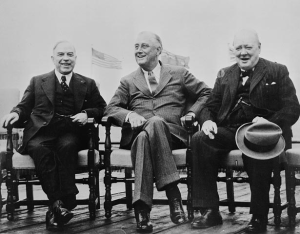![]() The Pacific War Online Encyclopedia
The Pacific War Online Encyclopedia
|
| Previous: QGA Sonar | Table of Contents | Next: Queen Elizabeth Class, British Battleships |

Library and
Archives Canada. Via Wikipedia
Commons
QUADRANT was the fourth major wartime diplomatic conference between Roosevelt and Churchill, following the TRIDENT conference of 12-27 May 1943. The conference was held at Quebec on 17-24 August 1943 and continued solidifying the basic Anglo-American strategy in the Mediterranean and plans for the invasion of northwest Europe. It was also at this conference that a formal decision was made to invade the Marianas following the seizure of the Palaus.
The conference began with an American effort to cement the decision to pull seven divisions out of Italy for the Normandy landings, which Brooke was reluctant to commit himself to. Brooke was in for an even greater disappointment, when the decision was made that an American would command the Normandy invasion. This was probably inevitable given the growing preponderance of American strength. Indeed, the QUADRANT conference marked the approximate point in the war when American military power began to surpass British military power, and the Americans began to assume the role of senior partner in the Anglo-American alliance.
The conference was the first occasion at which the Combined Chiefs of Staff considered plans for the final defeat of Japan. The proposed strategy was converging attacks from east and west, meeting at Hong Kong. This would then become the base for an advance into north China, with Japan being defeated by invasion or blockade in 1947.
However, there was concern that 1947 was much too pessimistic, and the
plan was modified to specify the defeat of Japan within a year of the
defeat of Germany. There was also much disagreement over the details of implementing the strategy.
The Americans continued to push for a greater effort in Burma. The British never gave Burma the same priority as the Americans: While the Americans believed China could make a great contribution to the war against Japan, but feared Chiang might drop out of the war, the British believed Chiang had no choice but to continue fighting but could make little contribution to final victory. Brooke argued against MacArthur's continued advance in New Guinea, while Churchill pushed his pet project, CULVERIN, an invasion of northern Sumatra aimed at the eventual recapture of Singapore. In the end, both the Central Pacific and New Guinea counteroffensives were allowed to go forward, and plans were approved to base B-29s in China when they became available; but ANAKIM (the invasion of Burma) and CULVERIN were both dropped.
In an effort to deflect American criticism that the British were unwilling to fight in Burma, Churchill brought Orde Wingate with him to the Quebec conference. The Chindit commander made little impression on Roosevelt, but he won over "Hap" Arnold, the U.S. Army Air Forces commander, who saw that the Chindits received a large allocation of ground support and transport aircraft and gliders. This transformed the Chindits into an airlanding force with capability for vertical envelopment rivaling that of paratroops.
During the meeting, Mountbatten demonstrated Pykrete, a frozen mixture of sawdust and ice proposed for constructing floating airfields, by firing a pistol at a block of the substance. The bullet ricocheted back into the room crowded with national leaders and senior officers, fortunately hitting no one. One of the staff officers waiting outside exclaimed, "Good heavens, they've started shooting now!" (Roberts 2009), a reflection of the tension that marked many of the Anglo-American diplomatic conferences.
One of the more important decisions to come out of the conference, so
far as the war against Japan was concerned, was to organize a Southeast Asia Command under Mountbatten. This was meant to bring some order to the confused command
situation, but the reality that China's armies could not be
subordinated to anyone but Chiang and Chiang to no one else, together
with the decision to make Stilwell the deputy commander of the new headquarters, meant that the command situation would continue to be problematic.
References
The Pacific War Online Encyclopedia © 2010, 2012, 2014 by Kent G. Budge. Index